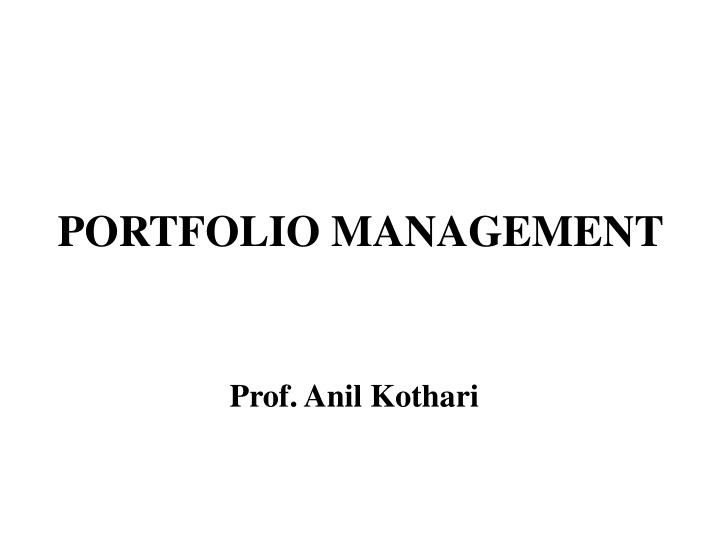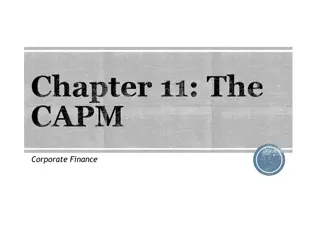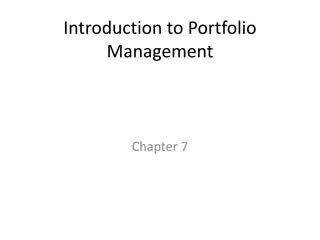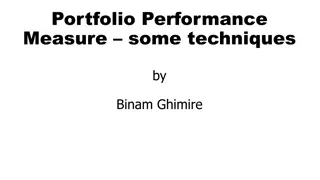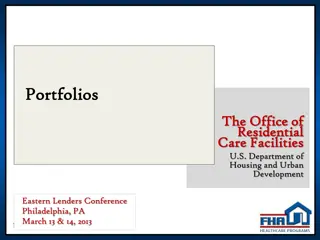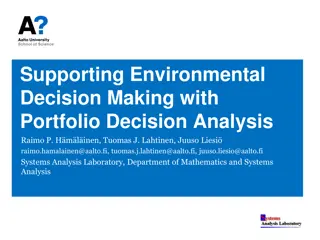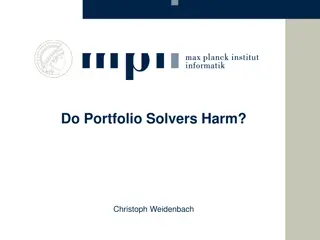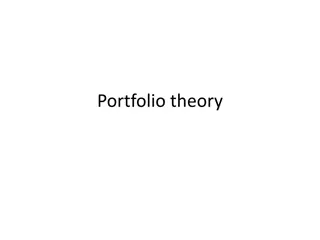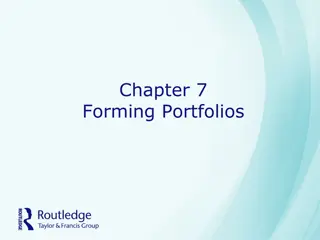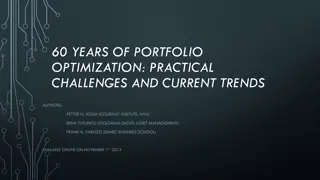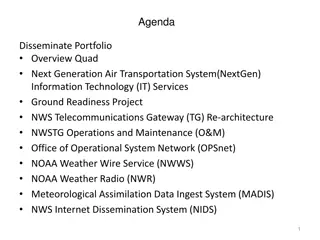Understanding Portfolio Management: An Overview
Portfolio management involves selecting the right investment policy to maximize returns while minimizing risks. It encompasses managing various investment tools like stocks, bonds, and mutual funds based on an individual's financial needs and goals. Through portfolio management, individuals can achieve a well-rounded investment plan tailored to their income, budget, and risk tolerance, ultimately aiming for optimal profits within a specific time frame. Different types of portfolio management, such as active and passive management, offer unique approaches to meeting investors' needs. Additionally, portfolio theories have traditionally relied on subjective analysis but have proven successful for some in evaluating securities and managing risk and return.
Download Presentation

Please find below an Image/Link to download the presentation.
The content on the website is provided AS IS for your information and personal use only. It may not be sold, licensed, or shared on other websites without obtaining consent from the author.If you encounter any issues during the download, it is possible that the publisher has removed the file from their server.
You are allowed to download the files provided on this website for personal or commercial use, subject to the condition that they are used lawfully. All files are the property of their respective owners.
The content on the website is provided AS IS for your information and personal use only. It may not be sold, licensed, or shared on other websites without obtaining consent from the author.
E N D
Presentation Transcript
PORTFOLIO MANAGEMENT Prof. Anil Kothari
What is a Portfolio ? A portfolio refers to a collection of investment tools such as stocks, shares, mutual funds, bonds, cash and so on depending on the investor s income, budget and convenient time frame. 2
What is Portfolio Management ? The art of selecting the right investment policy for the individuals in terms of minimum risk and maximum return is management. called as portfolio Portfolio management refers to managing an individual s investments in the form of bonds, shares, cash, mutual funds etc so that he earns the maximum profits within the stipulated time frame. Portfolio management refers to managing money of an individual under the expert guidance of portfolio managers. In a layman s language, the art of managing an individual s investment is called as portfolio management. 3
Need for Portfolio Management Portfolio management presents the best investment plan to the individuals as per their income, budget, age and ability to undertake risks. Portfolio management minimizes the risks involved in investing and also increases the chance of making profits. Portfolio managers understand the client s financial needs and suggest the best and unique investment policy for them with minimum risks involved. Portfolio management enables the portfolio managers to provide customized investment solutions to clients as per their needs and requirements. 4
Types of Portfolio Management Portfolio Management is further of the following types: Active Portfolio Management: As the name suggests, in an active portfolio management service, the portfolio managers are actively involved in buying and selling of securities to ensure maximum profits to individuals. Passive Portfolio Management: In a passive portfolio management, the portfolio manager deals with a fixed portfolio designed to match the current market scenario. Discretionary Portfolio management services: In Discretionary portfolio management services, an individual authorizes a portfolio manager to take care of his financial needs on his behalf. The individual issues money to the portfolio manager who in turn takes care of all his investment needs, paper work, documentation, filing and so on. In discretionary portfolio management, the portfolio manager has full rights to take decisions on his client s behalf. Non-Discretionary Portfolio management services: In non discretionary portfolio management services, the portfolio manager can merely advise the client what is good and bad for him but the client reserves full right to take his own decisions. 5
PORTFOLIO THEORIES TRADITIONAL PORTFOLIO analysis has been of a very subjective nature but it has provided success to some persons who have made their investments by making analysis of individual securities evaluation of return and risk conditions in each security. The PORTFOLIO believes maximization of return through a combination of securities. The modern portfolio theory discusses the relationship between different securities and then draws relationships between them. MODERN theory in the through inter- risks of 6
PORTFOLIO THEORIES TRADITIONAL was based on the fact that risk could be measured on each individual security through the process of finding out the standard deviation and that security should be chosen where the deviation was the lowest. Greater variability and higher deviations showed more risk than those securities which had lower variation. THEORY THE MODERN THEORY is of the view diversification risk can be reduced. Diversification can be made by the investor either by having a large number of shares of different Diversification is important but the modern theory states that there cannot be only diversification to achieve the maximum return. The theory of diversification was based on the research work by Harry Markowitz. that by companies in regions,. 7
PORTFOLIO THEORIES TRADITIONAL believes that the market is inefficient and the fundamental analyst can take advantage of the situation. By analysing internal financial statements of the company, he can make superior profits through higher returns. The technical analyst believed in behaviour and past trends to forecast the future of the securities. These analyses were mainly under the risk and return criteria security analysis. THEORY MODERN PORTFOLIO THEORY, as brought out by Markowitz and Sharpe, is the combination of the securities to get the most efficient portfolio. Combination of securities can be made in many ways. Markowitz developed the theory of diversification through scientific reasoning and method. the market of single 8
Harry Markowitzs Modern Portfolio Theory In 1952, an economist named Harry Markowitz wrote his dissertation on PortfolioSelection , a paper that contained theories which transformed the landscape of portfolio management a paper which would earn him the Nobel Prize in Economics nearly four decades later. As the philosophical antithesis of traditional stock selection, his Modern Portfolio Theory (MPT) continues to be a popular investment strategy, and this portfolio management tool if used correctly can result in a diverse, profitable investment portfolio. Instead of focusing on the risk of each individual asset, Markowitz demonstrated that a diversified portfolio is less volatile than the total sum of its individual parts. While each asset itself might be quite volatile, the volatility of the entire portfolio can actually be quite low. More than 60 years after its introduction, the fundamentals of MPT ring true. Let s delve into this popular portfolio management strategy, and discover what makes the principles of this revolutionary theory so effective. 9
Markowitz disagreed with this thinking. The presentvalue theory had shortcomings; selecting the best portfolio under this logic meant selecting a single stock with the highest expected NPV. That approach was risky by nature, and while economic experts believed a good portfolio was a diversified one, there was no methodology available for investors to achieve this diversity. Prior to the development of MPT, investing processes were centered on individual stocks; investors would look through available assets and find surebets assets that would produce decent returns without subjecting the investor to too much risk. Expected net present value (NPV) was used to distinguish these surebet stocks, while securities were valued by discounting their future cash flows. Stocks that were capable of generating more money at a quicker rate were given great value. 10
What is MPT? Markowitz created a formula that allows an investor to mathematically trade off risk tolerance and reward expectations, resulting in the ideal portfolio. This theory was based on two main concepts: 1. Every investor s goal is to maximize return for any level of 2. Risk can be reduced by diversifying a portfolio through individual, unrelated securities MPT works under the assumption that investors are risk- averse, preferring a portfolio with less risk for a given level of return. Under this assumption, investors will only take on high-risk investments if they can expect a larger reward. risk 11
What is Modern Portfolio Theory? An investment model like modern portfolio theory or MPT allows investors to choose from a variety of investment options comprising of a single portfolio for earning maximum benefits and that too at a market risk which is way lower than the various underlying investments or assets. Explanation Modern Portfolio Theory (MPT) is an investing model in which investors invest with the motive of taking the minimum level of risk and earning the maximum amount of return for that level of acquired risk. The modern portfolio theory is a helpful tool for the investors as it helps them in choosing the different types of investments for the purpose of the diversification of the investment and then making one portfolio by considering all the investments. According to the modern portfolio theory, all the investments that are selected are combined together in a way that reduces the risk in the market through the means of diversification and, at the same time, also generates a good return in the long term to the investors.
Example of the Modern Portfolio Theory (MPT) There is an individual who wants to invest in a portfolio. He got an option of two portfolios, which are as follows: 1.The first portfolio consists of a mix of the bonds and different stocks that gave the return of 10 % annually on an average, but at the same time differed by the range of as much as 15 % annually (returns, in this case, usually differed between -5 % and + 25 %). 2.On the other hand, the second portfolio consists of a mix of the bonds and different stocks that gave the return of 10 % annually on an average, but at the same time differed by a range of only 3 % annually (returns, in this case, usually differed between 7 % and 13 %) According to modern portfolio theory, which investment portfolio the person should consider? 13
Analysis In both scenarios, the average expected return on the investment is 10 %. However, in the first portfolio, one could get the return of as much as 25 %, which sounds attractive, but at the same time, there prevails a huge risk where one might lose 5 % as well because the range usually differs between -5 % and + 25 %. On the other side, in the case of the second portfolio, a less return range of between 7 % and 13 % may be less attractive to the investor, but in that case, it is expected that one will not lose his money, which makes the investment less risky than the first portfolio. According to the Modern portfolio, theory investor invests with the motive of taking the minimum level of risk and earning the maximum amount of return with that minimum risk taken, so in the present case, one should choose the second portfolio as he is getting the same average expected return with the less level of risk.
Assumptions of Modern Portfolio Theory Modern Portfolio theory has a certain assumption that is to be considered while making any decisions in order to arrive at the conclusion that risk, return, and diversification relationships hold true. The different assumptions of the modern portfolio theory are as follows: Returns from the assets are distributed normally. The investor making the investment is rational and will avoid all the unnecessary risk associated. Investors will give their best in order to maximize returns for all the unique situations provided. All investors are having access to the same information. The cost pertaining to taxes and trading is not considered while making decisions. All the investors are having the same views on the rate of return expected. The single investors along are not sizeable and capable enough to influence the prices prevailing in the market. Unlimited capital at the risk-free rate of return can be borrowed.
Advantages of the Modern Portfolio Theory (MPT) There are several different advantages of the Modern portfolio theory providing the opportunity for the investors investing their money in the market. Some of the advantages are of the Modern portfolio theory as follows: 1.It helps in evaluating and managing risks and returns associated with the investments. With the help of analysis, the assets which are underperforming assets and the assets having an excessive risk with respect to returns can be scrutinized and then replaced with the new one. 2.The theory is an important tool for avoiding financial ruin because by following these theories, traders don t rely on only one investment for their financial stability; rather, they diversify their portfolio in order to get the maximum return with minimum risk.
Disadvantages of the Modern Portfolio Theory (MPT) Along with the different advantages, there exist the limitations and drawbacks also of the Modern portfolio theory, which includes the following: 1.In the case of the modern portfolio theory, the past performance of the company under consideration is taken. The performance of the past never provides a guarantee for the result that could arise in the future. Considering only the past performances sometimes leads to overpassing the newer circumstances, which might not be there when historical data were considered but could play an important role in making the decision. 2.This theory assumes that there is a normal distribution of the return on an asset within a class of assets, which is proved to be wrong for individual equities as the correlations of asset class may change over the period of time. 3.In this theory, there is an assumption that securities of any of the sizes can be bought and sold, which doesn t hold true as some of the securities have minimum order sizes, which cannot be dealt with in the fraction. 4.Modern Portfolio Theory even though is accepted widely all over the world and also applied by different investment institution, but at the same time it has also been criticized by different persons particularly by representatives of the behavioral economics who challenges the assumptions of the Modern portfolio theory on the parameters of investor rationality and the expectations for the return. 17
Conclusion The main idea or the purpose of the Modern portfolio theory says that the risk is undertaken and return expected linked directly, which means that in order to achieve the greater rate of expected returns, an investor must have to take a higher level of risk. Also, the theory says that the overall risk of the portfolio having securities can be reduced through the means of diversification. In case two different portfolios are given to the investor having the same level of expected return, then the rational decision would be to choose the portfolio having lower total risk. Modern Portfolio Theory, even though it is accepted widely all over the world and also applied by different investment institutions, but at the same time, it has also been criticized by different persons. However, regardless of the different criticism, Modern portfolio theory is a working strategy having a diversified investment that is implemented by different risk managers, investment institutions, and related persons.
